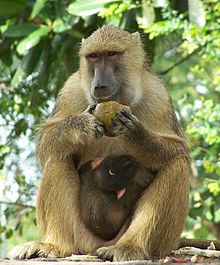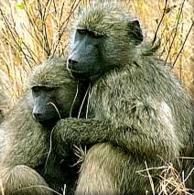 |
| hamadryas baboon |
 |
| yellow baboon |
Five species of
papio are commonly recognized, although there is some disagreement about whether they are really full species or subspecies. They are
P. ursinus (
Chacma Baboon, found in southern Africa),
P. papio (Western, Red, or
Guinea Baboon, found in the far western Africa),
P. hamadryas(
Hamadryas Baboon, found in the Horn of Africa and south-western Arabia),
P. anubis (
Olive Baboon, found in the north-central African
savanna) and
P. cynocephalus (
Yellow Baboon, found in south-central and eastern Africa). Many authors distinguish
P. hamadryas as a full species, but regard all the others as subspecies of
P. cynocephalus and refer to them collectively as "savanna baboons". This may not be helpful: it is based on the argument that the Hamadryas Baboon is behaviorally and physically distinct from other baboon species, and that this reflects a separate evolutionary history. However, recent morphological and genetic studies of
papio show the Hamadryas Baboon to be more closely related to the northern baboon species (the Guinea and Olive Baboons) than to the southern species (the Yellow and Chacma Baboons).
The traditional 5-form classification probably under-represents the variation within Papio. Some commentators argue that at least two more forms should be recognized, including the very tiny Kinda Baboon (P. cynocephalus kindae) from Zambia, the DRC, and Angola, and the Gray-footed Baboon(P. ursinus griseipes) found in Zambia, Botswana, Zimbabwe, Mozambique, and northern South Africa. However, current knowledge of the morphological, genetic, and behavioral diversity within Papio is too poor to make any final, comprehensive judgment on this matter.
 |
| chacma baboon |
 |
| guinea baboon |





